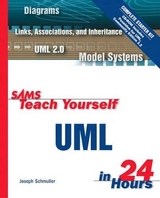
Sams Teach Yourself UML in 24 Hours
Sams Publishing (Verlag)
978-0-672-32238-9 (ISBN)
- Titel erscheint in neuer Auflage
- Artikel merken
Sams Teach Yourself UML in 24 Hours, 2E provides hands-on UML experience. Learn to use UML to build a model for any system development project, and understand the UML models that will undoubtedly form the basis for future system development books. Gain the knowledge and the confidence to become a UML champion in your organization by understanding topics such as Object Orientation, Using Links, Associations, and Inheritance, Working with UML Diagrams, Fitting UML into a Development Process, Modeling Deployment, and Modeling real-time Systems. Finally, the book provides a solid skill set allowing you to master an UML-based modeling tool.
JOSEPH SCHMULLER is a Functional Analyst with Convergys. From 1991 through 1997, he was Editor in Chief of PC AI Magazine. He has written numerous articles and reviews on advanced computing technology, and is the author of ActiveX No experience required and Dynamic HTML Master the Essentials. Holder of a Ph.D. from the University of Wisconsin, he is an Adjunct Professor at the University of North Florida.
(NOTE: Each chapter concludes with a Summary, Q&A, and Workshop.)
Introduction.
I. GETTING STARTED.
Hour 1. Introducing the UML.
Adding a Method to the Madness. How the UML Came to Be. The Components of the UML. Some Other Features. Why So Many Diagrams?
Hour 2. Understanding Object-Orientation.
Objects, Objects Everywhere. Some Concepts. The Payoff.
Hour 3. Working with Object-Orientation.
Visualizing a Class. Attributes. Operations. Attributes, Operations, and Visualization. Responsibilities and Constraints. Attached Notes. Classes-What They Do and How to Find Them.
Hour 4. Working with Relationships.
Associations. Multiplicity. Qualified Associations. Reflexive Associations. Inheritance and Generalization. Dependencies.
Hour 5. Understanding Aggregations, Composites, Interfaces, and Realizations.
Aggregations. Composites. Contexts. Interfaces and Realizations.
Hour 6. Introducing Use Cases.
Use Cases: What They Are. Use Cases: Why They're Important. An Example: The Soda Machine. Including a Use Case. Extending a Use Case. Starting a Use Case Analysis.
Hour 7. Working with Use Case Diagrams.
Representing a Use Case Model. Visualizing Relationships Among Use Cases. Use Case Diagrams in the Analysis Process. Applying Use Case Models: An Example. Taking Stock of Where We Are. The Big Picture.
Hour 8. Working with State Diagrams.
What Is a State Diagram? Substates. History States. Messages and Signals. Why Are State Diagrams Important?. Building the Big Picture.
Hour 9. Working with Sequence Diagrams.
What Is a Sequence Diagram? The GUI. The Soda Machine: Instance and Generic. Creating an Object in the Sequence. Representing Recursion. Building the Big Picture.
Hour 10. Working with Collaboration Diagrams.
What Is a Collaboration Diagram? The GUI. The Soda Machine. Creating an Object. A Few More Concepts. Building the Big Picture.
Hour 11. Working with Activity Diagrams.
What Is an Activity Diagram? Applying Activity Diagrams. Swimlanes. Hybrid Diagrams. Building the Big Picture.
Hour 12. Working with Component Diagrams.
What Is a Component? Components and Interfaces. Types of Components. What Is a Component Diagram? Applying Component Diagrams. Component Diagrams in the Big Picture.
Hour 13. Working with Deployment Diagrams.
What Is a Deployment Diagram? Applying Deployment Diagrams. Deployment Diagrams in the Big Picture.
Hour 14. Understanding the Foundations of the UML.
The Structure of the UML. The Metamodel Layer: Up Close and Personal. Extending the UML. Stereotypes.
Hour 15. Fitting the UML into a Development Process.
Methodologies: Old and New. What a Development Process Must Do. GRAPPLE. RAD3: The Structure of GRAPPLE. The GRAPPLE Wrap-up.
II. A CASE STUDY.
Hour 16. Introducing the Case Study.
GRAPPLEing with the Problem. Discovering Business Processes. Lessons Learned.
Hour 17. Performing a Domain Analysis.
Analyzing the Business Process Interview. Developing the Initial Class Diagram. Grouping the Classes. Forming Associations. Forming Aggregates and Composites. Filling Out the Classes. General Issues About Models. Lessons Learned.
Hour 18. Gathering System Requirements.
Developing the Vision. Setting Up for Requirements Gathering. The Requirements JAD Session. The Outcome. Now What?
Hour 19. Developing the Use Cases.
The Care and Feeding of Use Cases. The Use Case Analysis. The Server Package. Components of the System.
Hour 20. Getting into Interactions and State Changes.
The Working Parts of the System. Interactions in the System. Implications.
Hour 21. Designing Look, Feel, and Deployment.
Some General Principles of GUI Design. The GUI JAD Session. From Use Cases to User Interfaces. UML Diagrams for GUI Design. Mapping Out System Deployment. Next Steps. …And Now a Word from Our Sponsor.
Hour 22. Understanding Design Patterns.
Parameterization. Design Patterns. Chain of Responsibility. Our Own Design Patterns. The Advantages of Design Patterns.
III. LOOKING AHEAD.
Hour 23. Modeling Embedded Systems.
The Mother of Invention. Fleshing Out the GetAGrip. What Is an Embedded System? Embedded Systems Concepts. Modeling the GetAGrip. Flexing Their Muscles.
Hour 24. Shaping the Future of the UML.
Extensions for Business. Lessons from the Business Extensions. Graphic User Interfaces. Expert Systems. Web Applications. That's All, Folks.
IV. APPENDIXES.
Appendix A. Quiz Answers.
Appendix B. Modeling Tools for the UML.
Common Features. Rational Rose. Select Enterprise. Visual UML. The Ideal Modeling Tool.
Appendix C. A Summary in Pictures.
Activity Diagram. Class Diagram. Collaboration Diagram. Component Diagram. Deployment Diagram. Sequence Diagram. State Diagram. Use Case Diagram.
Index.
| Erscheint lt. Verlag | 3.9.2001 |
|---|---|
| Verlagsort | Indianapolis |
| Sprache | englisch |
| Maße | 188 x 232 mm |
| Gewicht | 699 g |
| Themenwelt | Mathematik / Informatik ► Informatik ► Programmiersprachen / -werkzeuge |
| Informatik ► Software Entwicklung ► Objektorientierung | |
| Informatik ► Software Entwicklung ► UML | |
| ISBN-10 | 0-672-32238-2 / 0672322382 |
| ISBN-13 | 978-0-672-32238-9 / 9780672322389 |
| Zustand | Neuware |
| Informationen gemäß Produktsicherheitsverordnung (GPSR) | |
| Haben Sie eine Frage zum Produkt? |
aus dem Bereich



